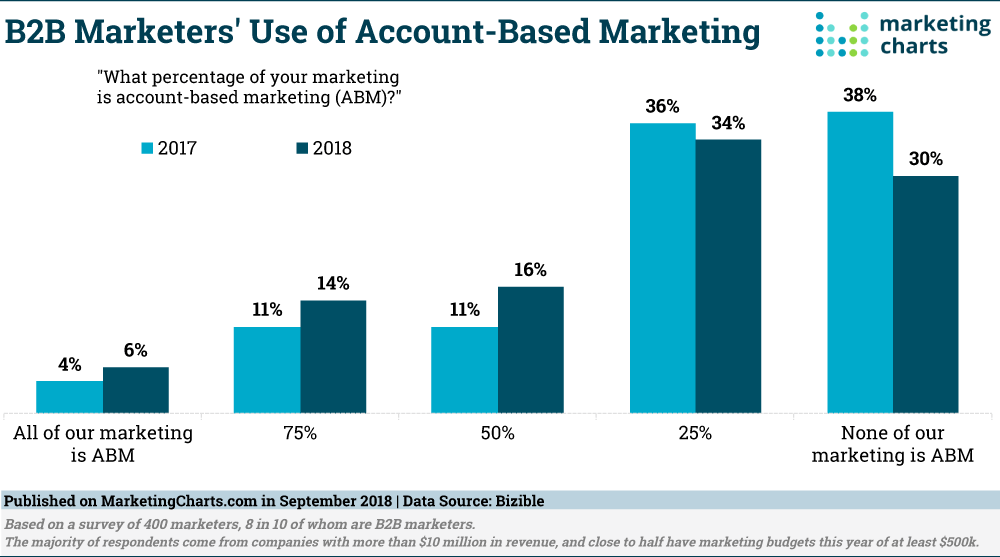
by SmarkLabs | Sep 2, 2020 | Marketing Strategy
Whenever you hear the phrase “product positioning,” you most likely associated it with a B2C market. This is common since most B2C products are tangible and more clearly defined, making them easier to position in a market and compare against competitors.
But even as a B2B company, your “products” still pertain to a specific mindset with your clients. So, the important question is, what is your positioning strategy doing about it?
The Top 4 Things to Keep in Mind for B2B Product Positioning
The Product Itself
Okay, this one might seem obvious, but many times it can be overlooked. If you don’t know your product inside and out, how will you position it effectively?
First, evaluate your “product.” Ask yourself these questions:
- What client needs does it fill?
- What is the top benefit? Does is provided additional features?
- How is it different from your competitors?
In a B2B space, ask the additional question of “How does my product better help other businesses?”. To fully understand your product, you must honestly consider why clients should purchase it. Once you break down and comprehend the who, what, why of your product, it will be easier to strategize your product positioning.
The Buyer Persona
Building a buyer persona can be done in 5 easy steps, but applying it to a B2B positioning strategy maybe a little more complicated.
Product positioning is an implementation tool under the STP model (standing for Segmentation, Targeting, and Positioning). This model helps marketers identify their most valuable customers and then develop products and marketing messages that suit them. This range of customers is then represented by a buyer persona, based on their behavior patterns, motivations, goals, and demographics.
Personas give you a better idea of the market and who your targeted clients should be. So when you’re developing your product positioning, you can have a better understanding of who your customers are and how your products fill their needs.
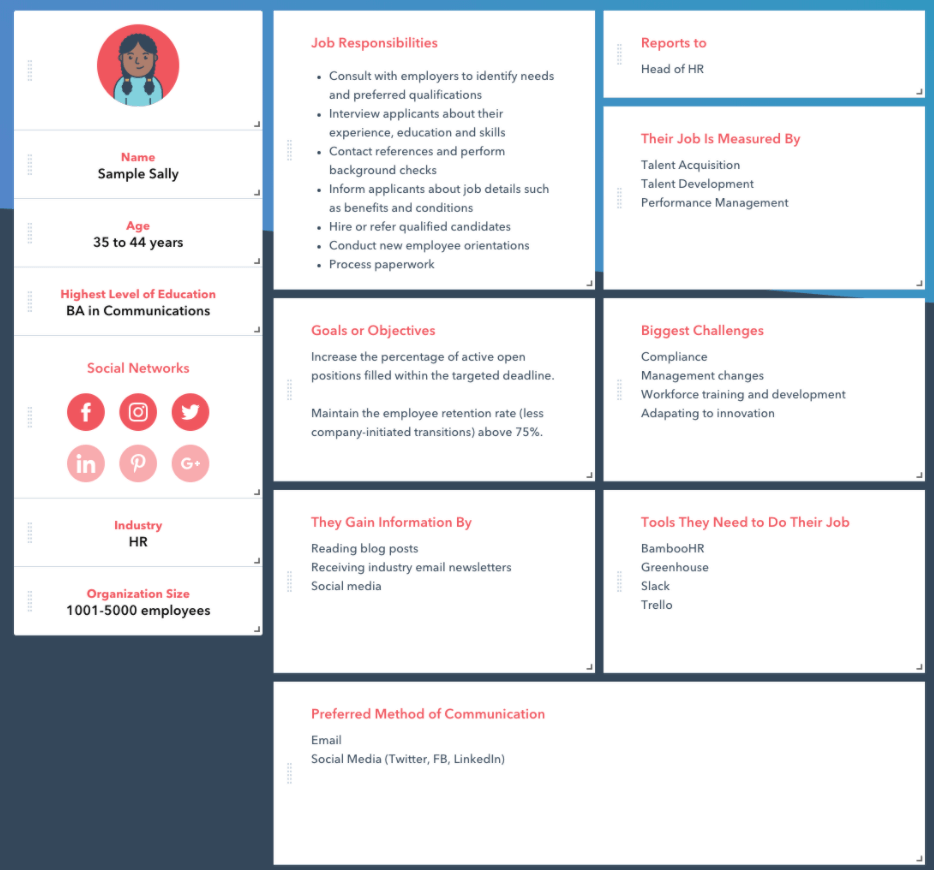
Your Competitors
Time to do some digging.
A deficient comprehension of your clients’ alternatives can make for a poor understanding of the market and who you are actually up against. You need to understand how your customers see your product against your competitors to impact how you market and position your product.
Know who your competitors are and, more importantly, study them — the good, the bad, and the ugly. Have an idea of what you’re up against. Then, combat it by providing the necessary, need-to-know product information in your sales spiel and marketing collateral, so clients have everything they need to make an informed decision. Would you rather your potential clients formed impressions of your product from your organization itself or a lowly Google Search?
The Market
Alongside your competitors, it’s also vital to evaluate the structure of your industry’s market. For example, let’s take a look at this perceptual product positioning map.
Perceptual mapping helps organizations visually analyze how their target market perceives their product. When creating a perceptual map, the axes should represent your customers’ criteria when buying products in your market.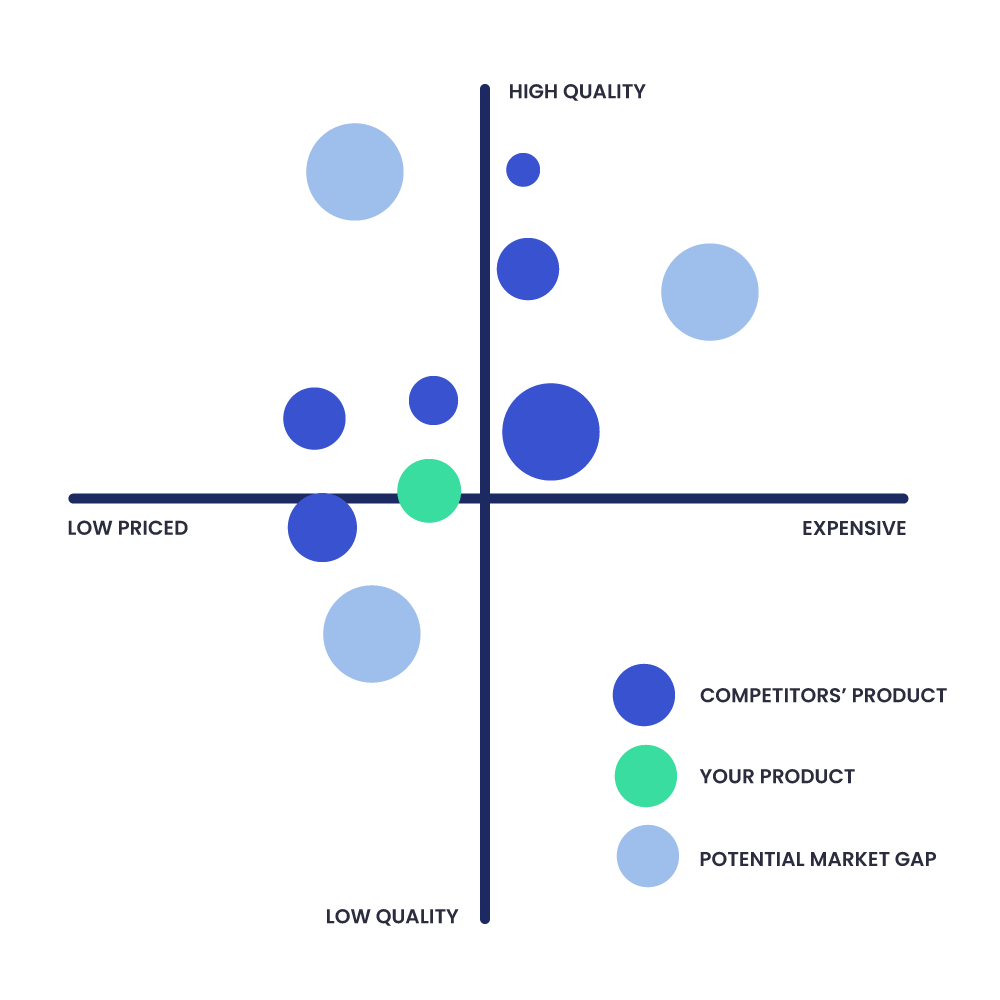
Hypothetically, let’s say this graph represents your industry’s current market (dot size representing market share). Using your knowledge of client perception (either through surveys or one on ones), you’ve landed in what seems to be the center of your market. Looks a little crowded there, agreed?
When it comes to analyzing the market, it’s crucial to look at market gaps. Why? Because it’s where a potential market opportunity might lie. Gaps could mean untouched customers for your positioning strategy. However, market gaps should be taken with a grain of salt. Gaps can also exist because there is no customer need, or provides unrealistic financial means for an organization.
While market gaps can be up for discussion, there is one thing that is for sure — you need to know your market in order to have a successful product positioning strategy.
Need some help with your positioning strategy? Leave it to the experts. Drop us a line, and we’d be happy to help.

by SmarkLabs | Aug 17, 2020 | Marketing Strategy
If you’re a professional marketer, you know that significant growth doesn’t usually happen overnight. Sometimes, it can take weeks, months, or even years of building up your marketing strategies to produce targeted goals and results.
Don’t you wish there was a way to know if your strategies worked while further helping your business grow to its full potential? Lucky for you, there is!

What is Growth Marketing?
Growth marketing, growth hacking, performance marketing… You’ve heard these interchangeable phrases used before, but what do they mean?
Growth marketing is an integrated approach of constant testing across marketing channels with the goal of scaling and optimizing your business. The purpose of a growth marketer is to find new ways to build and engage your organization’s audience.
A growth marketer is keen, creative, analytical, and scrappy — all at once. They will test and experiment with new concepts and content until they find an approach that enables significant growth.
For example, have you ever conducted A/B testing? Congratulations, you’re already on your way to being a growth marketer! As the purpose of A/B testing is to test the effectiveness of content based on performance, it’s essentially a growth marketing strategy without the label.

Why is Growth Marketing Important?
Since not all industries or markets are alike, there are unfortunately no clear cut rules to direct and guide everyone’s marketing strategies. While overtime marketing best practices have developed, when it comes to an individual’s brand, there are never any guarantees for what will work and what will not. Traditional strategies usually involve “set it and forget it,” burning through resources like time and money, with no intention of maintaining potential customers’ attention.
This is where testing and experimentation become valuable. When it comes down to it, brands turn to growth marketing to provide them with creative, innovative, and low-cost strategies to achieve business scalability.
Notably, growth marketing is exceptionally substantial for content marketers. It helps them discover new ways to communicate with audiences, whether it’s testing a new marketing channel or a piece of content. Using the evidence of analytics, marketers can then integrate the best performing content into their strategies without worrying about its effectiveness.
Low-Cost Growth Marketing Strategies to Help You Get Started
For marketers accustomed to traditional marketing approaches, this level of experimentation can look overwhelming or even impossible. How is it possible to produce large amounts of growth with limited resources? Fear not! Here are a couple of convenient ways to implement growth marketing with content you already have.
A/B Testing
Like mentioned before, A/B testing is growth marketing in disguise. To run an A/B test, you’ll need to create two versions of the same content piece (or just slightly alter a piece of content you’ve already created). This can work for multiple types of content — landing pages, social ads, emails, etc. The ultimate goal is to use analytics and decide which version resonates best with your audience.
Look into search ranking
Investigate where your business ranks when it comes to specific search terms. You can do this with Google Analytics and other SEO tools, or simply conduct a search using incognito mode. Not only does this provide feedback on where your SEO might work, but can also give insight into competitors, ideas for content creation, and more.
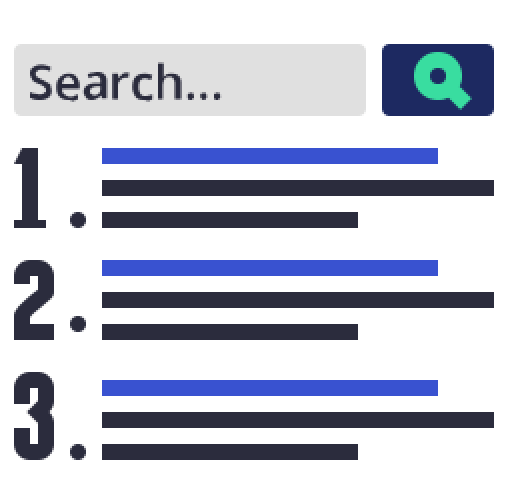
Feedback from current users
You don’t have to let analytics do all the talking. As the best source of product information, your customers can provide feedback to improve any current business function, including marketing. Whether it’s with surveys or client one on ones, get the answers you need to encourage business progression.
Audit your current content
Growth marketing is all about staying up to date with trends in the industry and uncovering new marketing tactics that take advantage of growth opportunities. Techniques that worked a few years ago could now not be the most effective way to generate consumer engagement continuously. What’s not performing as well as you would like it to, and more importantly, what’s the solution to fix it? Make it a point to frequently review what you produce so it can achieve its full potential.

Want more examples of growth marketing implementation? You can find more here, but don’t limit yourself to just those. There are several resources out there including SmarkLab’s Growth Plays — a complete playbook of 50 unique campaign ideas and tactics to help prioritize your marketing efforts.
Assess in your current strategy what elements or content may benefit most from growth marketing and start there. By applying growth marketing, you’ll be able to maximize your marketing strategy backed by data and analytics while contributing to your business’s growth.
Get the most out of your content by letting us help implement your growth strategy. Drop us a line to get started!

by SmarkLabs | Aug 10, 2020 | Content Marketing, Marketing Strategy
Picture this: You’re scrolling through social media and see an ad from one of your favorite brands. It’s amusing and witty and, honestly, makes you chuckle out loud. You’re captivated by the cleverness as a consumer, but as a B2B marketer, it makes you feel down. Why do B2C companies get to have all the creative fun? As a B2B marketer, you should be able to apply fun and fresh ideas to your B2B content marketing as well. Here’s the good news: you can! And more importantly, you should.
The ways of B2B marketing are beginning to shift to allow more engagement with potential clients through content marketing. With new resources and technological developments available, marketers can now experiment and attempt new B2B content strategies to find ones that best fit their brand.
 The Benefits of Mixing Up Your B2B Content Marketing
The Benefits of Mixing Up Your B2B Content Marketing
Your audience doesn’t get bored
Are you using the same content over and over again? As an audience member who gets unvarying content repeatedly, it can get stale and monotonous pretty quickly. Your largest missed opportunity results from being too cautious with your content. Being creative and bold with your B2B content marketing allows you to experiment with new avenues and find which content your audience connects with most.
Positions your company as innovative
As you explore more with new strategies, your content will begin to diversify. By not being basic or consistent, your audience will notice that. As a result, they will continue to look to you for more inventive ways to learn about your brand and products.
Makes content creation easy
If you are worried about not having enough substance to support your content, look no further than what you already have. By repurposing old content, you are still emphasizing any features or benefits about your company or products to your audience but just in new, exciting ways. That blog article you wrote? Make it a webinar. The social post you created? Convert it to paid media. Don’t give yourself more work than you have to.

Content to Try if You Haven’t Done So Already
Time to spice it up! Catch your audience’s attention with these different ideas:
According to Hubspot research, more than 50% of consumers want to see videos from brands more than any other type of content. This means if you aren’t already creating videos, you’re likely falling behind. Videos have become dominant in content strategy, especially when it comes to social media. Audiences look to video marketing as a new medium that provides information, entertainment, and education.
As podcasts have significantly increased in popularity over the past few years (U.S. weekly podcast listeners averaged seven podcasts a week in 2019), this is another new medium that your brand can experiment with. Like blogs or whitepapers, podcasts can help your brand establish an influential presence in your industry, positioning your team as experts and thought leaders.
Paid media can be a whole other strategy of its own, but it’s important to incorporate it into B2B content strategies. In the 2019 Content Marketing Institute research overview, they found that 71% of the most successful B2B content marketers use paid methods to distribute content. If you currently aren’t using paid media, you could be missing out on opportunities to engage with targeted audiences that might be interested in your products.
This can vary based on your resources, but trying new initiatives like interactive PDFs, new social media features, or infographics (the fourth most used type of content marketing according to Hubspot) are bound to capture audience engagement.
If you’re STILL are running short on ideas to spice up your B2B content marketing, check out these examples done by other B2B companies.

The Power Behind Strategizing Your Content
Finally, produce content that your audience WANTS to see. Don’t create content just because you think your feed is a little dry. Creating an idea without any intentions or initiative is a waste of time and resources. Every piece of your B2B content marketing should be backed by strategy with an end goal, whether it’s capturing leads, ramping engagement, or establishing brand awareness. In this case, quality does come before quantity.
As B2B content marketing is continuously evolving, that means your content strategy should be doing the same. Use these pointers to start assessing what improvements can be made to your strategy, and you’ll be on your way to having content that your audience can’t help but engage with.
Don’t fret over running out of content. Let us help! We’re here to generate the perfect B2B content marketing strategy that best fits your brand.

by SmarkLabs | Aug 3, 2020 | Marketing Strategy
Have you ever heard the phrase “Always be launching”? It may seem pretty straightforward, but it’s definitely easier said than done. Fortunately, a go-to-market strategy can help make this more possible than you might realize.
A go-to-market strategy is the process of how a company brings their products to the market. Generally, this additionally includes any planning, researching, or preparing that happens before a product launch. When releasing a new product or feature, you definitely don’t want to waste any time and resources throughout the process. Without planning, there is no knowing notable factors about entry to the market, like audience or market saturation.
So Go-To-Market strategies are obviously important, but why make them repeatable?
The reason behind why a recurring go-to-market strategy is so significant is because it positions your business as innovative and progressive. It’s not hard to deny that people like new “news”, especially if it’s in relation to new products or features that interest them. By implementing a GTM strategy, you are continuously engaging with your customers’ interests for your products while creating a wow factor and perception of success. Positioning yourself as “up and coming” will give your customers that serious sense of FOMO (fear of missing out) whenever there are any missed releases.

Go-To-Market Strategy Development
What does the Go-To-Market process entail?
First, you need to establish your “event”. Don’t worry about creating a big occasion or a new product launch just to push news out to an audience. Here are some potential ideas that your GTM strategy can rally around:
- Feature or Service Updates
You want your current customers to have the best version of your product (and they want that too!) Keep them aware of your products’ updates so they can continue to be satisfied.
Continuing to enhance your products is all about furthering yourself in the market and rising above competitors. Alert your customers to show them why they are already using the best in the business.
Announcing that trial period gets people hooked on your product while also creating loyal customers in the making.
What’s Next?
Now that you have your options of “events”, here’s the important part: making it repeatable. For each release you have, it is possible to create and build reusable elements that will fuel weeks of content.
The Announcement
This is the presentation of your news. Whether it’d be weeks leading up to or the day of, there are various ways to get your audience excited. It can vary anywhere from social and email to news articles and press releases (or a combination of all of these). As a company expert, you’ll know the best way to reach your audience.
The Exclusive Story
When creating an event, details are critical if you want your audience to stay informed. Craft a write-up about the significance of the release including items like the use case, the problems it solves, or the opportunities it creates. If you are pitching to media, this is almost required, but don’t let that restrict you from repurposing it for other content like your website or your blog.
The How-To
Allow your customers to get the tangible details of the release by including tutorials, guides, and documentation.
The Webinar
The How-To but essentially repurposed to video format. With this new medium, you can further extend information to customers while still talking about the details of your products. And there’s a bonus: Set the webinar up as gated content and allow tracking for leads and potential new clients.
Earned or Paid Media (optional)
Try and find a way to fit your news into your pre-existing content strategy with paid and owned media. Promoting this content helps drive exposure and engagement to your release. Now combine this with any earned media — positive reviews of the new feature, current customers’ recommendations, coverage in an industry trade — and you’re well on your way to a successful launch.
And there you have it! An easy yet effective way to use the tools you already have to start building your go-to-market strategy from the ground up. Remember to keep exciting your customers and “always be launching”.
Get the best tips and tricks on go-to-market strategies from the experts. Drop us a line and let’s get started!

by SmarkLabs | Jul 27, 2020 | Marketing Strategy
Here’s the bottom line: In today’s market, to guarantee the utmost visibility in any industry, effective B2B positioning requires some sort of strategy. Rising above competitors is getting tougher as more and more contenders seem to enter the market. And while marketing efforts can be optimized or revamped, there is one element that underlies as a foundation for all: positioning.
Let’s take a look at what “positioning” is and why it may be the most important (but one of the most difficult) building blocks for your company’s growth.

What Exactly Does “Positioning” Mean?
Here is what is positioning is NOT:
- Positioning is NOT branding. While both involve actively shaping your brand, positioning is how your brand sits in consumers’ minds.
- Positioning is NOT “marketing’s job.” Ultimately, it’s the CEO or founder’s job to lead the way on what the positioning will be. Marketing can, of course, take on a role in the process, but their job is more heavily involved later on in implementing the strategy through the messaging.
- Positioning is NOT just a statement. As you develop strategic B2B positioning, that brand story should weave itself into every element of your company.
Here is what positioning IS:
Positioning IS perception. The story that consumers and clients have created in their minds about your company and your brand. As positioning is composed of many different elements, from marketing and branding to service and social responsibility, it is crucial to create a clear and captivating customer perception with a strategy so clients choose your product and/or services to fill their needs every time.
Developing Your Positioning Strategy

The Buyer Persona
What are the ideal needs of your clientele? While every client may have different problems or difficulties, remember your job as a company is to solve those key pain points by providing a solution. Creating that buyer persona helps consolidate what needs your company should focus on filling and therefore, positioning your story around. Generally, the best persona to pursue would be the one who has the highest distress, simply because they are more likely to shift towards your solution if their needs aren’t currently being met.
Additionally, ask your current clientele for their input. This will help focus your areas of what customers’ perceptions are of not just your products, but your strategic B2B positioning as well. Ask questions like:
- What do they like about your product?
- What is the predominant benefit they receive?
- Why did they switch to your product?
- What do they wish was better?

The Competition and the Market
Where do you see your company fitting into the market? In consumers’ minds, you are already competing against other contenders, so make sure you know what you’re up against. One of the best ways is to simply gather competitive intelligence, whether that be from their website, blogs, social media and notably, reviews. Reviews are key to revealing what approvals — or disapprovals — current consumers are experiencing with your competitors’ products. How can your company fill these needs that your competitors aren’t delivering their promises on?
Do research not just on your competitors, but the industry as well. Where is the market demand now but more importantly, where is it going? Use your positioning to fill the empty void in your market to reach a new consideration of clients and maybe even contemplate the opportunity of creating your own category.

Differentiation and Consistency
That distinguishing factor that makes your company stand out from your competitors? USE it. This is what positioning is all about. See that a compelling story is crafted so your company will stand out from the competition and brand advocates will continuously share with anyone who listens.
Once you’ve established a brand position, keep to it. The second you change your brand’s story, you confuse your clients. Remember consistency happens across your whole positioning strategy — not just one individual element. This should include the messaging you are using for your marketing, ensuring that the delivery is centered around your story.
While there are several guiding principles to elevating your strategic B2B positioning, due to the differences and challenges each individual industry is facing, unfortunately, there is no one standard solution. As a specialist in your industry, you will know the in and outs of the market to implement the best possible positioning for your company — these are simply just tools to help you get started.
Still feeling overwhelmed by strategic B2B positioning? Leave it to the experts! Drop us a line and we’d be happy to help.

by SmarkLabs | Feb 24, 2020 | Marketing Strategy
In an industry loaded with buzzwords, it can be tough to determine which ones will fade into obscurity and which will shake up the whole B2B world. In case you haven’t noticed by now, account-based marketing, or ABM, falls into the latter category.
While it’s been a go-to strategy for quite some time, it’s picked up a lot of steam in recent years. In 2018, the ABM Leadership Alliance reported that 80% of survey respondents were less than two years into their ABM implementation. And 99% of marketers reported more significant ROI from their ABM programs than their other marketing strategies.
This strategy takes a B2B company’s marketing resources and applies them to its target accounts, rather than an all-encompassing marketing strategy. Information Technology Services Marketing Association, or ITSMA, coined the phrase in 2004, defining it merely as “treating individual accounts as markets in their own right.”
How ABM works the Inbound Methodology
Fundamentally, the inbound methodology is about adding value and helping buyers identify and solve problems. This methodology can be used with ABM, taking a highly targeted approach. It can be very content-focused, creating highly personalized content for a very defined market segment. Its main objective is to create high-quality content that’ll have prospects seeking you out. ABM, however, is focused on targeting specific prospects and existing accounts. Its purpose isn’t to replace your overall, broader marketing strategy—it supplements it.
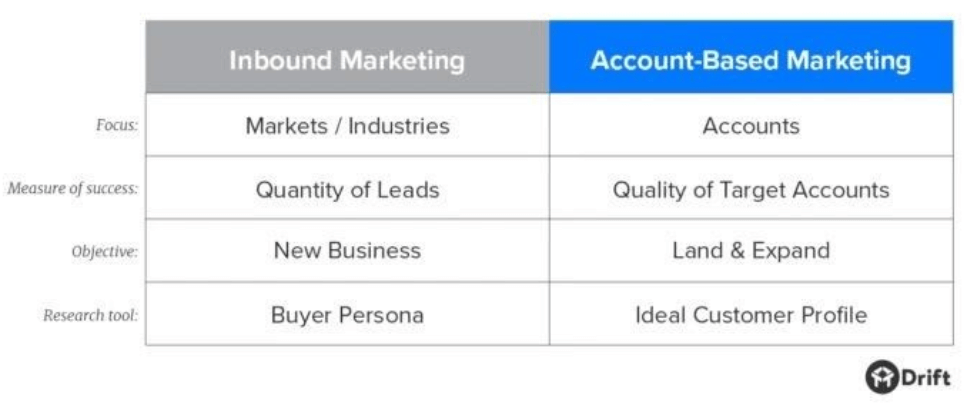
Image: Drift.com
Sam Balter, a senior marketing manager at HubSpot, points out that many aspects of ABM incorporate inbound marketing—that ABM can be used to build better relationships with target accounts.

Why ABM?
Account-based marketing can have a significant impact on businesses targeting niche markets with a high average deal size. HubSpot’s nailed down six of ABM’s huge benefits:
Personalization yields better return on marketing efforts
One of the biggest struggles for marketers is the attempt to appeal to such a wide range of potential buyers. When it comes to ABM, though, you’re narrowing the pool down. Then, you’re able to tailor the experience to each lead.
It’s easier to see the return on investment
The optimistic ROI is such a massive draw to ABM, and it makes sense that you want to see the results. When you’re implementing an ABM campaign, you’re able to determine how much new business is a result of that campaign specifically, and whether it’s worth continuing.
You spend less time on marketing campaigns that don’t yield new business
An asset of seeing that ROI in cold hard numbers is that you quickly learn what’s worthy of your time, money, and energy. According to HubSpot, “ABM is like an insurance policy for your team!”
With the right targeting, sales cycles should decrease
The sales cycle is a necessary evil in marketing, but we all wish it could be a little shorter, right? Well, in ABM, you’re targeting prospects that are more likely to cruise through the process. So then, you can focus that energy that you would typically spend nurturing, pursuing new leads.
It fortifies your relationship with existing clients
A good relationship with a client is the unsung hero of the marketing world. It’s no secret that people want to feel a more personal connection with people with whom they’re working. Not only does this keep you in tune with their ever-changing needs, but it’s also how you get renewals and referrals.
It quickly aligns your sales and marketing teams
Have we told you how much we love a proper alignment between sales and marketing yet? Read on!
Sales and marketing alignment
An essential tenet of ABM is creating alignment between sales and marketing. The process of creating an ABM strategy itself is likely to develop a bond between the two teams working on it. After all, it’s beneficial for both sides—as well as the client!
In the words of Megan Golden on LinkedIn:
“At a more granular level, ABM is a win-win-win for sales, marketing, and customers. ABM perfectly complements the account-based approach sales teams have embraced for years. With the dedicated involvement of marketing, sales teams can better personalize their outreach. Nurturing targeted members of the buying committee with appropriate marketing messages tends to speed up the sales process, allowing sales to achieve better close rates while closing bigger deals faster.”
The adoption of account-based marketing
Marketing Land suggests a big reason that a lot of B2B companies are dragging their feet when it comes to implementing an ABM strategy is the fear that doing so will require a giant restructuring of the organization’s marketing strategy and team.
Sure, change is scary, especially when it disrupts something you’ve been doing for years that’s been working fine. But why stick with something that works fine when you can try a strategy that’s known to produce better results?










 The Benefits of Mixing Up Your B2B Content Marketing
The Benefits of Mixing Up Your B2B Content Marketing











